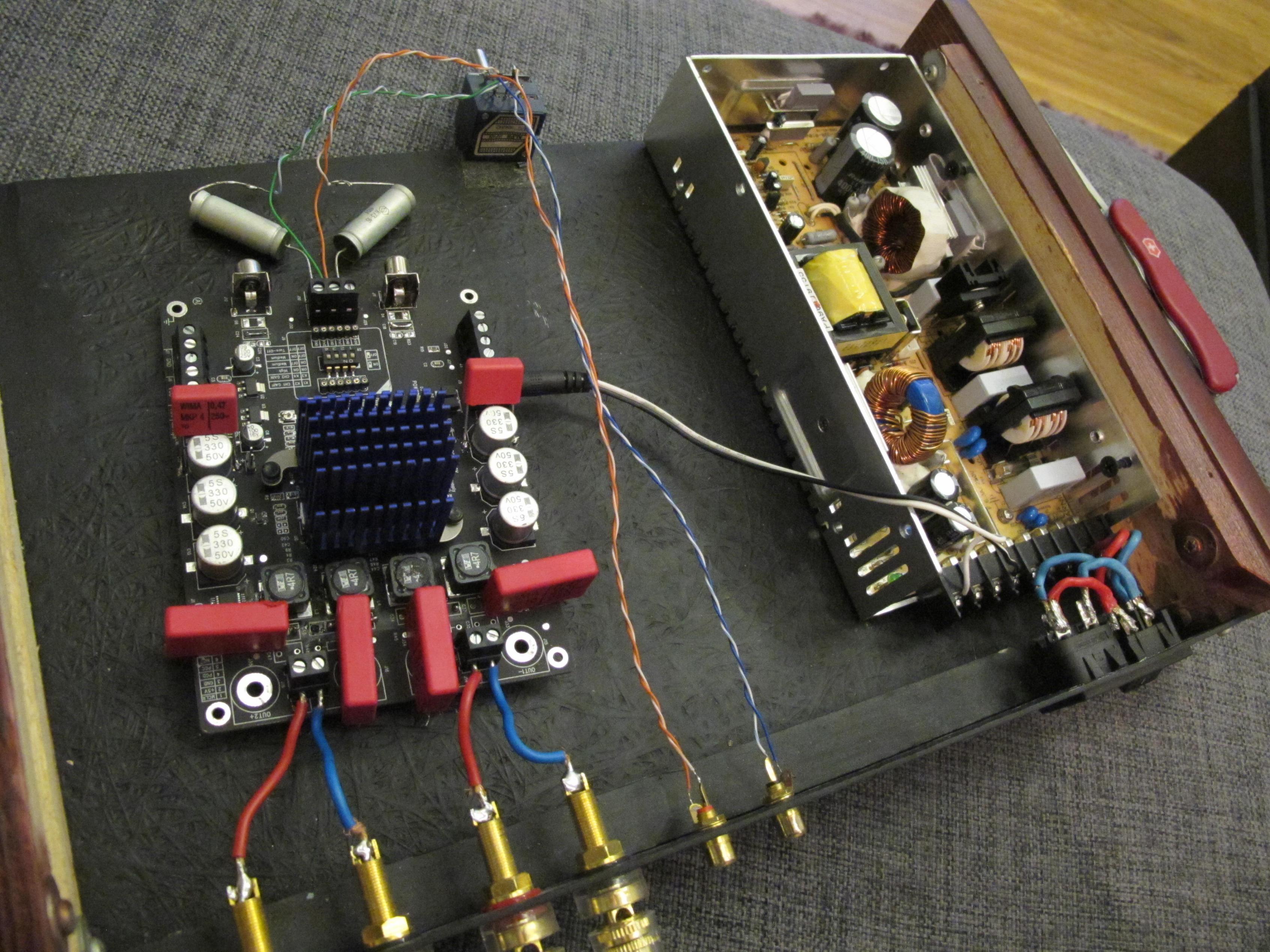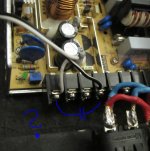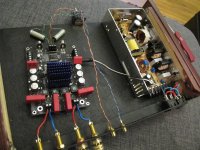27V DC will be the best solution. Also keep in mind that these boards have a very high failure rate , so don't invest much money on it. I had one dead on arrival, the 2nd had problems with the temperature control & the 3rd worked about 3 months (with mods) and now makes a loud noise when power on & becomes stable after 2 seconds. Not so reliable. I found that the best solution are the amps hifimediy is selling (T1 & T2 are very reliable & don't need mods). If you build your own PSU that bridge rectifier is ok, just put some 0.1uf mkp's there for high frequency filtering.
hi guys,
after all readings i'm confused about the psu voltage?! according to Sure 24-30v max 32v. and many other comments here and there. which voltage gives the best sq? not loudness or watt!
i'm trying to build my psu finally. is 26mb60a bridge rectifier a good solution? or any better?
Last edited:
I also had 3 boards, all dead!!! It is not that I hate Sure, as they replaced 2 of them, but just a warning.
Hmmm.... Sounds like the Sure 7498 boards may still not be ready for prime time. Too bad...this chipset, if properly filtered at the output, provides somewhat more power than the TK2050 version, and can be run at up to 32V DC power supply. However, the open question is...is the sound from the 7498 into good speakers as unusually good as the results from the Tripath boards?
Rumor has it that the new high power boards using the IR dual supply chipset and the TI high power chipset offer better sound quality than the older ICEPOWER and Crown Class D designs. As noted in some of the posts above, however, small changes in the output low pass filters and input coupling can make a very large difference in sound quality (and actual, measured results, too, I have read elsewhere). Regardless, I can state that the 2 channel and 4 channel Sure TK2050 boards produce very good results into high quality transducers, though perhaps a touch less good than some of the low power Tripath chip designs. In other words, yes, if you pay peanuts, often the results are monkey business, but there are a few (laboratory grown) diamonds in the mix, too.
Rumor has it that the new high power boards using the IR dual supply chipset and the TI high power chipset offer better sound quality than the older ICEPOWER and Crown Class D designs. As noted in some of the posts above, however, small changes in the output low pass filters and input coupling can make a very large difference in sound quality (and actual, measured results, too, I have read elsewhere). Regardless, I can state that the 2 channel and 4 channel Sure TK2050 boards produce very good results into high quality transducers, though perhaps a touch less good than some of the low power Tripath chip designs. In other words, yes, if you pay peanuts, often the results are monkey business, but there are a few (laboratory grown) diamonds in the mix, too.
I am right now listening to a pair of AMP11 boards of 41hz that have been ON non stop since 2007!! I have had the AMP32 in my car PERMANENTLY on live (also at starting the car!) for two years and that amp is now doing a job as test amplifier at my workbench. These amps when well built and handled are rugged as can be!! Oh and the AMP11 are running on 35Vdc!
I can only say if you want to have a completed amp then buy either the Hifimediy boards, or get something from Arjen Helder. The latter are fairly good designs, only some cheaper (though adequate) components as the other. 41hz parts are still superior to all though....
I can only say if you want to have a completed amp then buy either the Hifimediy boards, or get something from Arjen Helder. The latter are fairly good designs, only some cheaper (though adequate) components as the other. 41hz parts are still superior to all though....
I guess the expression haste makes waste is applicable here then. The smell of money probably made them cut some corners short...
thanks vmed_cha_gr I have very little knowledge in electronic. just of curiosity wonder why 27v? would you develop it please.
best regards
best regards
That has been repeatedly reported to be the point where the temperature of these boards is still acceptable, above that you need a nuclear power plant water cooling system to keep it down enough.
The beauty of switchmode circuits should be efficiency....(scratch on head)
The beauty of switchmode circuits should be efficiency....(scratch on head)
At idle the Kill-a-watt says it draws 9w from the wall. With Barry White playing nice and loud it's still drawing 9w from the wall. The amp is very efficient. The 20,600uF I added appears to be buffering the peaks quite a bit. I suspect most of the 9w is going off as heat, but considerably cooler than a regular class AB.
The board is definitely not an optimized layout. Jan at 41hz paid careful attention to keep the traces short and strategically put capacitance in place to address oscillation. The amp6 is a good example where small capacitors are placed right on the pins from the Tripath chip. 🙂
The Sure Electronics is nice to look at, but I'm guessing nobody ever put a oscilloscope on it. The R&D was skipped. ...but it is super cheap.
The board is definitely not an optimized layout. Jan at 41hz paid careful attention to keep the traces short and strategically put capacitance in place to address oscillation. The amp6 is a good example where small capacitors are placed right on the pins from the Tripath chip. 🙂
The Sure Electronics is nice to look at, but I'm guessing nobody ever put a oscilloscope on it. The R&D was skipped. ...but it is super cheap.
Yes it is, thats why are bought three of them, all of them are dead now ;(
Testing should be better done as well as R&D.
Testing should be better done as well as R&D.
The worst part is that Tripath chips are on a dead end running stock and wasted on these junk products in my humble opinion....
I totally agree with you. Sure electronics needs good QC to make their products respectful in the market.
The worst part is that Tripath chips are on a dead end running stock and wasted on these junk products in my humble opinion....
one of my 2x100 smoked last night, but i think my sound card messed up and sent some crazy signal to them it was so loud when my pc turned on something like 8k Hz to the ear at full blast , these 2 boards have been on for 3 years non stop..
Connect one leg of the cap to GROUND and another to COM. I think 0.1uF is enough.
This alone might not work to get rid of the noise since all the caps you replaced have those long legs that are working like antennas and polluting your signal. Bigger is not always better.
This alone might not work to get rid of the noise since all the caps you replaced have those long legs that are working like antennas and polluting your signal. Bigger is not always better.
Last edited:
HF feedback, you should be glad the amp is not extremely powerful, smoke is not excluded from the special effects if it would have been.
That is a high frequency output filter, you may have noticed the inductors have an extremely low value, close to just a wire. All the 'extension leads' you have added to the parts that don't actually fit on the board will introduce tremendous parasitic inductance radiating and picking up the switching signals. Apart from that you have chosen extremely inductive capacitors. As said above small is key in a high frequency output filter!
I've never seen a Tripath amplifier on which grounding was done properly either, not even my most favorite ones. I always take extra special care to make sure the ground at the audio input side (AGND) is not making any unnecessary connections, then one single connection to the power ground (PGND) through a little inductor (to block any unwanted switching noise) and then keep all these isolated from the casing/earth.
That is a high frequency output filter, you may have noticed the inductors have an extremely low value, close to just a wire. All the 'extension leads' you have added to the parts that don't actually fit on the board will introduce tremendous parasitic inductance radiating and picking up the switching signals. Apart from that you have chosen extremely inductive capacitors. As said above small is key in a high frequency output filter!
I've never seen a Tripath amplifier on which grounding was done properly either, not even my most favorite ones. I always take extra special care to make sure the ground at the audio input side (AGND) is not making any unnecessary connections, then one single connection to the power ground (PGND) through a little inductor (to block any unwanted switching noise) and then keep all these isolated from the casing/earth.
I'm aware of that. Not to mention very long and poorly shielded connection wires. I'm just ordering some new, well shielded cable.
So connection looks just like on my sketch. And no resitor ? ElFishi once used 20mF. You advised 0,1uF. Huge difference.
So connection looks just like on my sketch. And no resitor ? ElFishi once used 20mF. You advised 0,1uF. Huge difference.
Didn't look like you are aware of that...
What would be the point of more capacitance on an SMPS? It runs on high frequency and that tops off the caps in a split second. Apart from that the high capacitance can cause the PS to oscillate as it becomes rather a big load on the high switching frequency.
100nF is fine, just to shunt any noise to ground, but it should already be present on the amp. They are most effective nearest to the load and furthest from the lead inductance. Placing it on the PS output is therefore far from ideal.
What would be the point of more capacitance on an SMPS? It runs on high frequency and that tops off the caps in a split second. Apart from that the high capacitance can cause the PS to oscillate as it becomes rather a big load on the high switching frequency.
100nF is fine, just to shunt any noise to ground, but it should already be present on the amp. They are most effective nearest to the load and furthest from the lead inductance. Placing it on the PS output is therefore far from ideal.
Another look at this pic suggests even more that you are not that aware... What would be more important, keeping the input leads short or the output leads?

Surely the input leads. Hence the use of extension shafts in many designs for the potentiometer. I am not even that worried about thise twisted pairs, they'll do fine when kept short.
Good lay-out and proper grounding is far more important than sticking on a couple of 'fancy' parts....

Surely the input leads. Hence the use of extension shafts in many designs for the potentiometer. I am not even that worried about thise twisted pairs, they'll do fine when kept short.
Good lay-out and proper grounding is far more important than sticking on a couple of 'fancy' parts....
I am now 🙂 When I did this amp a year ago I had no idea.. 🙂 Anyway I have no skills/resources/time to make an extension shaft. But I would be vary glad to have one istalled.
Do you think there is any point in adding this 0.1uF short when I have those caps on input and output ?
Do you think there is any point in adding this 0.1uF short when I have those caps on input and output ?
- Status
- Not open for further replies.
- Home
- Amplifiers
- Class D
- Sure Electronics New Tripath Board tc2000+tp2050

